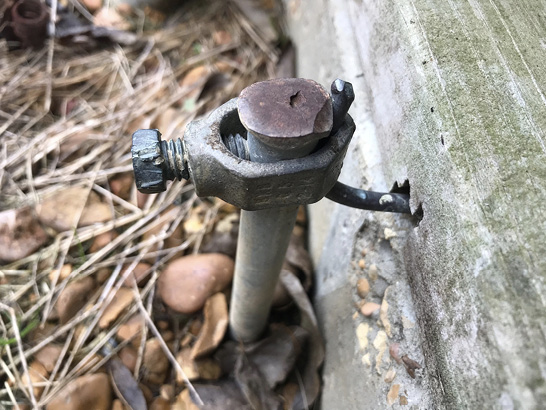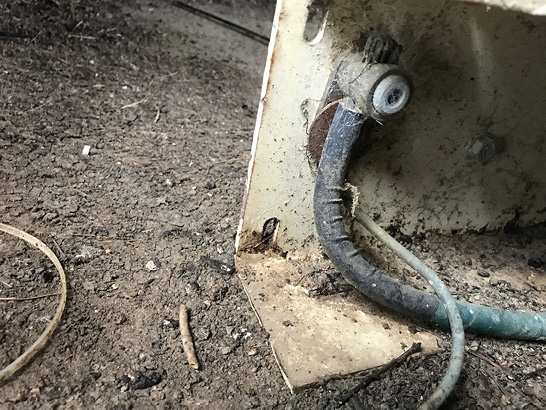Poultry Farm Insurers Expect Proper Earth Grounding
It is critical that poultry growers have properly earth-grounded control rooms, feed bins, generator sheds, and generator frames. A lack of proper grounding on the farm is not only dangerous to people and poultry, but it also increases the risk of equipment damage and failure. Ground rods, grounding lugs, and ground wires are all critical parts of a poultry farm’s electrical system and are required for preventing damage from lightning storms and power surges.
The National Electrical Code (NEC), Article 100, defines a ground as “a conducting connection, whether intentional or accidental, between an electrical circuit or equipment and the earth, or to some conducting body that serves in place of the earth.” Growers should regularly check grounding points to make sure the grounding system is secure and intact and will do its job when needed. If lightning damage occurs and a claim is filed, insurers will inspect to determine whether or not the grower had taken every precaution to ensure proper earth grounding of equipment.
Understanding Grounding
There are two parts to a grounding system: earth grounding and equipment grounding. The two parts of the system must be kept separate, except for a single connection between the two. Earth grounding is an intentional connection from a circuit conductor, usually the neutral, to a ground electrode (rod) driven into the earth (Figure 1). A proper equipment ground protects the operating equipment within a structure. In addition to protecting people and poultry, a properly grounded poultry house provides a safe path for the dissipation of fault currents, lightning strikes, and static discharges.

Ground rods should be driven deep into moist earth. The ground wire connections should be tight on both ends. Copper ground wires should be free of damage and must be sized to meet NEC requirements. It is recommended to use copper clad ground rods that are at least 8 feet long by 5/8 inch in diameter with solid acorn-style grounding lugs that tighten with a bolt (Figure 1) instead of two-piece pipe clamps. Experience indicates that most two-piece clamps loosen and are more prone to failure over time.
A simple grounding system includes a ground conductor (the grounding wire), the grounding lug that connects the ground wire to the ground rod, and the electrode (ground rod) itself. When installing grounding systems, focus your attention on ways to reduce the ground resistance. The resistance of the ground electrode and its connection is usually quite low. Ground rods are often made of material that is high conductance/low resistance such as copper or steel. In addition, the contact resistance of the surrounding earth to the electrode is almost negligible if the ground electrode is free of grease, paint, and similar materials, and the ground rod is in firm contact with the earth.
The NEC code requires a minimum ground rod length of 8 feet to be in contact with the soil. Longer is better to further lessen the ground resistance. There are four factors that may affect the ground resistance of a grounding system:
- Ground rod length
- Ground rod diameter
- Number of ground rods
- Ground system design
Increasing the length of the ground rod above the 8-foot minimum and driving it deeper into the soil is an effective way of lowering ground resistance. Soil is never uniform or consistent in its resistivity and can be highly unpredictable. Moist areas make better contact because moisture helps reduce resistance. The ground rod must be driven below the frost line so that resistance to ground will not be greatly affected by freezing and thawing of the surrounding soil.
In most cases, doubling the length of the ground rod will reduce resistance level by an additional 40 percent. However, there are occasions where it is physically impossible to drive ground rods 8 feet deep. Areas that are composed of rock, granite, or similar material may require alternative methods, such as grounding to cement. In contrast to increasing the length, increasing the diameter of the ground rod has little effect on lowering the resistance. Doubling the diameter of a ground rod will decrease the resistance only about 10 percent.
Multiple ground rods can be driven to further lower resistance. In this scenario, more than one ground rod is driven into the earth and connected in parallel to lower the resistance. However, for additional ground rods to be effective, the spacing (or distance) between the additional rods must be at least equal to the depth of the driven rods. Each ground rod influences the soil near it. Multiple ground rods must be far enough apart that their influence areas do not overlap. Otherwise, resistance will not be lowered.
Lightning Protection
The NEC has developed acceptable codes for wiring farm buildings. Poultry farms often have the main farm service panel at the meter pole, where there will also be disconnects for electric lines going to each poultry house. Electric lines should be underground and in conduit from the meter pole to the chicken houses. Overhead power lines should never be near chicken houses where large feed, live haul, and chick delivery trucks must operate. The standby generator and automatic transfer switch may also be located at or near the meter pole. However, this is not always the case, particularly on farms with multiple standby generators. The NEC recommends that grounding devices should be tested to make sure they read no more than 25 ohms electrical resistance to earth ground. Unfortunately, many poultry farms may be over this 25-ohm threshold because of soil characteristics, improper grounding connections, and lack of maintenance on the grounding system.
Linhoss and Purswell (2019) tested earth ground resistance at multiple broiler, broiler breeder, and pullet houses in Mississippi, and found that all grounded feed bins and 12 out of 29 houses had resistances above the recommended 25 ohms at the control room breaker box. On many poultry farms today with electronic controllers, alarm systems, telephone dialers, and other sensitive equipment, a resistance of 5 ohms or less would be a better goal to strive for. However, rock and soil characteristics on many farms may make that goal practically unobtainable. In such cases, the absolute lowest ground resistance value obtainable that makes sense from both an economical and physical standpoint should be the goal in ground resistance. Soil composition, temperature, and moisture content all affect soil resistivity. Most soils are rarely homogenous, and resistivity varies geographically and at different depths. Moisture content changes based on season and varies according to the nature of the sublayers of the earth and depth of the water table.
Lightning strikes represent serious challenges to poultry farm electrical systems. There are four ways lightning can enter a farm building:
- By directly striking the building
- By striking a metal object extending out from the building such as a roof ventilator or cupola
- By striking feed bins or a nearby tree and leaping over to the building for a more direct path to ground
- By striking and following overhead utility power lines or by striking an ungrounded wire fence attached to a building
Many experts believe that 90 percent of all lightning damage can be prevented on farms with properly grounded electrical systems. Proper grounding is more critical today because of all the high-tech, expensive, electronic equipment found in poultry house control rooms that was not there a few years ago (Donald et al., 2004). This electronic equipment must be properly installed and grounded to prevent serious damage from power surges or lightning strikes. A lightning strike contains a huge amount of energy, and it does not take a direct hit to damage today’s sensitive electronic equipment.
Steps to Ensure Proper Grounding
Electrical equipment (feeders, fans, lights, etc.) may work, but it will not work safely without proper grounding. Proper grounding protects you (Moyle et al., 2018), your birds, sensitive electronic equipment, and the entire electrical system from costly repairs, stray voltage, fires, and possibly fatal accidents. Make sure that your farm’s electrical system meets NEC grounding standards. This will likely require the assistance of a qualified electrician, but it is money well spent, and it is necessary to protect you, your workers, your birds, and your equipment. Table 1 can help you assess the electrical safety situation on your farm. However, it is not a substitute for a thorough professional electrical inspection, so if you are having electrical issues, contact a qualified electrician immediately and have the problem checked out.
|
YES |
NO |
Mark yes or no for each question. |
|---|---|---|
|
YES |
NO |
Was the electrical system installed by a qualified electrician? |
|
YES |
NO |
Was the electrical system inspected by an electrical inspector? |
|
YES |
NO |
Does the building have a single electrical service entrance? |
|
YES |
NO |
Is the service entrance at each building equipped with a grounding rod? |
|
YES |
NO |
Are feed bins and standby generators equipped with ground rods? |
|
YES |
NO |
Do all electrical panels have at least 3 feet of clearance, and can all panel doors be opened at least 90 degrees? |
|
YES |
NO |
Are all enclosures, thermostats, switches, receptacle boxes, and covers water-tight, dust-tight, and made of corrosion-resistant materials? |
|
YES |
NO |
Are all cables and cable fittings designed for use in a wet or damp location? |
|
YES |
NO |
Is all conduit non-metallic and surface-mounted? |
|
YES |
NO |
Is all metallic equipment properly grounded? |
|
YES |
NO |
Are all grounding and neutral conductors electrically separated except in the main disconnect panel? |
|
YES |
NO |
Are all light fixtures made of corrosion-resistant material? |
|
YES |
NO |
Do all cables and conduits enter junction boxes from the side or bottom whenever possible? |
|
YES |
NO |
Are all motors totally enclosed and rated for farm-duty service? |
|
YES |
NO |
Are all metallic building components within 8 feet of the ground or floor bonded to the electrical grounding system? |
|
YES |
NO |
Do family members and all hired farm workers know where and how to disconnect power in case of an electrical emergency? |
|
YES |
NO |
Do family members and all hired farm workers know first aid for electrical shock and/or burns? |
Adapted from Wisconsin Farm Electrical Council.
Don’t Forget the Standby Generator
Power failures on the poultry farm can occur without warning because of severe weather or other circumstances. A standby electrical power system can protect your birds, your equipment, and your livelihood in the event of a power failure. A standby generating system consists of a generator, which produces electricity when utility line power goes down, and an automatic transfer switch, which safely connects the generator to the farm wiring system and prevents any interconnection between the standby generator and the power lines. Electrical codes require that a suitable transfer switch be used to disconnect the electrical load from the power lines and connect it to the standby generator. When properly installed, the transfer switch prevents backflow of electricity into power lines, which could endanger the lives of power line personnel working on power lines miles from your farm. The transfer switch also protects the standby equipment from being damaged by electrical feedback coming from power lines once line power has been restored.
Equipment must be installed correctly. Therefore, do not try to install the generator or transfer switch yourself! An improperly installed standby generator system can endanger you, power line company employees, and the general public, not to mention severely damage equipment and/or property. Consult a qualified electrician who can identify the farm’s voltage requirements, help determine the capacity size of your generator, and advise you on correct electrical installation and connection.
One final item is to make sure that the generator frame is grounded to a ground rod (Figure 2), either the main one at the shed or a separate rod all to itself. Often, the generator itself will only be grounded through the neutral back to the transfer switch. This is not sufficient. Without a frame ground, there is a much greater chance that a lightning strike that hits the transfer switch will also damage the computer controller on the generator (Brothers et al., 2011). If both the transfer switch and generator are damaged, there is no way to provide power to the poultry farm in the event of a power failure.

Summary
As poultry farm insurance becomes more difficult to find and keep, growers must do all they can to ensure that insurance providers will continue to write policies to insure their poultry farms. An important step in this process is to make sure that the poultry farm has proper earth grounding at all control rooms, feed bins, generator sheds, and generators. Ground rods, lugs, and wires are all vital parts of a poultry farm’s electrical system. Check these components at least annually and verify that the grounding system is intact. Use copper clad ground rods that are at least 8 feet long by 5/8 inch in diameter with solid acorn-style grounding lugs. Grounding devices should be tested to make sure they read no more than 25 ohms electrical resistance to earth ground. If a minimum of 25 ohms cannot be obtained with one ground rod, multiple ground rods should be driven and connected in parallel to further lower resistance. Don’t overlook standby generators and automatic transfer switches, and remember that generators should be fully serviced at least once a year. In the business of poultry farming, insurance is a necessity, so do all you can to protect and keep it.
References
Brothers, D., J. Campbell, J. Donald, and G. Simpson. 2011. Avoiding electrical catastrophe. Poultry Engineering, Economics, and Management Newsletter. No 71. National Poultry Technology Center. Auburn University.
Donald, J., M. Eckman, and G. Simpson. 2004. Stopping lightning and other electrical problems that can kill birds. Poultry Engineering, Economics, and Management Newsletter. No 32. National Poultry Technology Center. Auburn University.
Linhoss, J., and J. Purswell. 2019. Proper earth grounding in Mississippi poultry houses can prevent lightning damage. Mississippi State University Extension Service. Publ. No. 3321. February.
Moyle, J., J. Rhodes, T. Tabler, and S. Collier. 2018. Poultry farm electrical safety: Know how to recognize and prevent potential hazards. University of Maryland Extension. Fact Sheet, FS-1069. March. Available at: https://extension.umd.edu/learn/publications/poultry-farm-electrical-safety. Accessed: February 3, 2020.
Wisconsin Farm Electrical Council. 2011. Farming safely and efficiently with electricity. Available at: https://mrec.org/files/2011/02/farmsafe.pdf. Accessed: December 12, 2019.
Publication 3427 (POD-03-20)
By Tom Tabler, PhD, Extension Professor, MSU Poultry Science; Jonathan R. Moyle, PhD, Extension Poultry Specialist, University of Maryland Extension; Shawna L. Weimer, PhD, Poultry Extension Assistant Professor, University of Maryland; Jonathan Moon, Poultry Operation Coordinator, MSU Poultry Science; and Jessica Wells, PhD, Assistant Clinical/Extension Professor, MSU Poultry Science.
Copyright 2020 by Mississippi State University. All rights reserved. This publication may be copied and distributed without alteration for nonprofit educational purposes provided that credit is given to the Mississippi State University Extension Service.
Produced by Agricultural Communications.
Mississippi State University is an equal opportunity institution. Discrimination in university employment, programs, or activities based on race, color, ethnicity, sex, pregnancy, religion, national origin, disability, age, sexual orientation, genetic information, status as a U.S. veteran, or any other status protected by applicable law is prohibited. Questions about equal opportunity programs or compliance should be directed to the Office of Compliance and Integrity, 56 Morgan Avenue, P.O. 6044, Mississippi State, MS 39762, (662) 325-5839.
Extension Service of Mississippi State University, cooperating with U.S. Department of Agriculture. Published in furtherance of Acts of Congress, May 8 and June 30, 1914. GARY B. JACKSON, Director
The Mississippi State University Extension Service is working to ensure all web content is accessible to all users. If you need assistance accessing any of our content, please email the webteam or call 662-325-2262.




